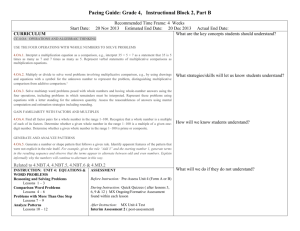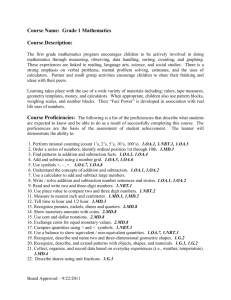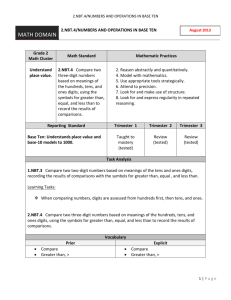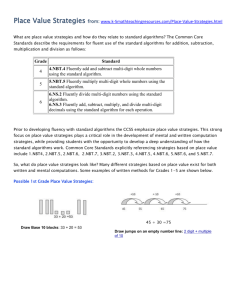Nature Materials_2013_Supp
advertisement
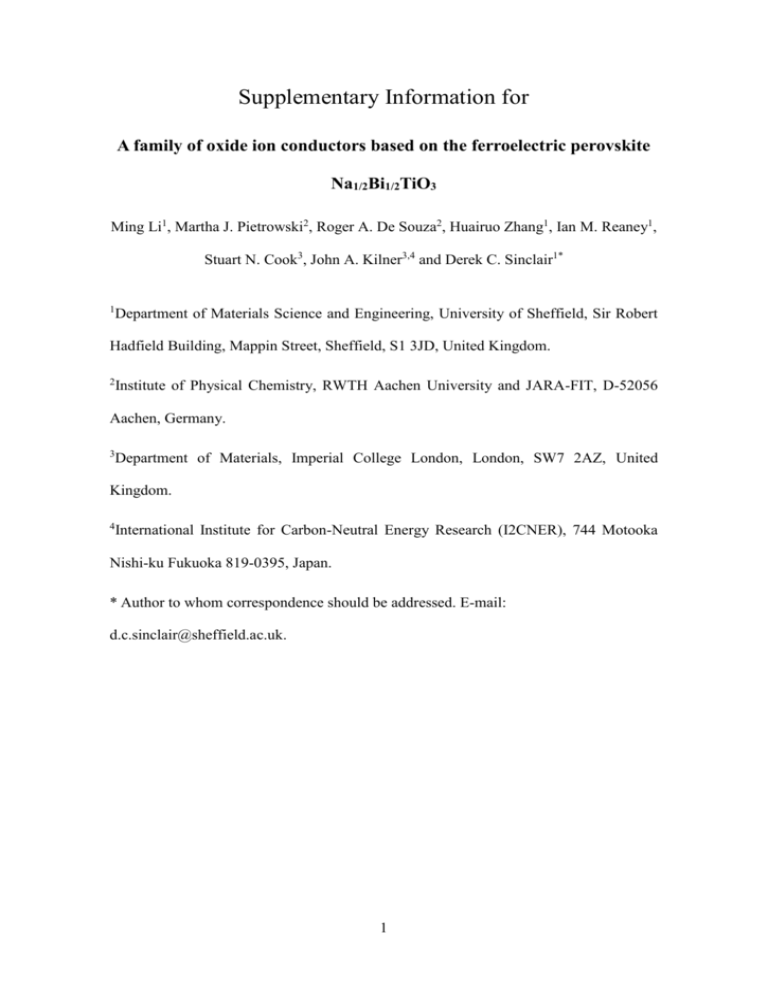
Supplementary Information for
A family of oxide ion conductors based on the ferroelectric perovskite
Na1/2Bi1/2TiO3
Ming Li1, Martha J. Pietrowski2, Roger A. De Souza2, Huairuo Zhang1, Ian M. Reaney1,
Stuart N. Cook3, John A. Kilner3,4 and Derek C. Sinclair1*
1
Department of Materials Science and Engineering, University of Sheffield, Sir Robert
Hadfield Building, Mappin Street, Sheffield, S1 3JD, United Kingdom.
2
Institute of Physical Chemistry, RWTH Aachen University and JARA-FIT, D-52056
Aachen, Germany.
3
Department of Materials, Imperial College London, London, SW7 2AZ, United
Kingdom.
4
International Institute for Carbon-Neutral Energy Research (I2CNER), 744 Motooka
Nishi-ku Fukuoka 819-0395, Japan.
* Author to whom correspondence should be addressed. E-mail:
d.c.sinclair@sheffield.ac.uk.
1
Methods
Na2CO3 (99.5%), Bi2O3 (99.9%), TiO2 (99.9%) and MgO (99%) were used as raw
materials. Prior to weighing, Na2CO3, Bi2O3, TiO2 and MgO were dried at 300, 180,
800 and 1000 oC for 8 h, respectively, followed by cooling in a vacuum desiccator. TiO2
and MgO were cooled in a furnace down to 300 oC before being transferred to a
desiccator. Mixtures of raw materials were ball milled using Y2O3-stabilised ZrO2
grinding media for 6 h, dried, sieved and calcined at 800 oC for 2 h. The resultant
powders were ball milled for 4 h followed by a second calcination at 850 oC for 2 h and
ball milled for 6 h. Green bodies were first pressed in a uniaxial steel die and then
isostatically pressed at 200 MPa, followed by sintering at 1150 oC for undoped
compositions and at 950-1100 oC for Mg-doped NBT. All samples were sintered for 2 h
in air. Prior to sintering the pellets were covered using powders of the same composition
to reduce Na-and Bi-loss during the firing process. Pellet density was estimated by the
Archimedes method and compared to that expected from the theoretical X-ray density.
Phase purity was checked by X-ray diffraction (XRD) using a high-resolution STOE
STADI-P diffractometer (STOE & Cie GmbH, Darmstadt, Germany) operating with Cu
Kα1 radiation. Data were collected over the 2θ range 10-90◦ with a linear position
sensitive detector (PSD).
Cross sections of pellets were polished, carbon-coated and examined using a Scanning
Electron Microscope (SEM) JEOL 6400 (JEOL Ltd., Tokyo, Japan) equipped with an
Oxford Link ISIS (Oxford Instruments Ltd., Oxfordshire, UK) Energy Dispersive X-ray
Spectroscopy (EDS) detector. Grain compositions were obtained by EDS on polished
samples (without thermal etching).
2
Average compositions of samples after sintering were measured by Inductively Coupled
Plasma - Atomic Emission Spectroscopy (ICP-AES). The sintered pellets were crushed
and ground into fine powders. The samples were then dissolved in a mixture of 3 ml of
concentrated nitric and 1 ml of concentrated HF and analysed by a Spectro-Ciros-Vision
spectrometer (SPECTRO Analytical Instruments GmbH, Kleve, Germany).
Electron transparent Transmission Electron Microscopy (TEM) specimens were
prepared by mechanical grinding followed by dimpling and ion-milling. TEM
characterisation was performed using a Philips EM420 TEM (120 kV) and a JEOL 3010
TEM (300 kV), both equipped with high tilt angle specimen holders, as well as a JEOL
2010F TEM/STEM (200 kV) equipped with a high angle annular dark-field (HAADF)
detector, an Oxford Instruments EDS system and Gatan Image Filter (GIF) system.
High temperature Impedance Spectroscopy (IS) measurements1,2 were performed using
an HP 4192A (Hewlett Packard, USA) Impedance bridge or a Solartron 1260 system
(Solartron Analytical, United Kingdom) in a non-inductively wound tube furnace. Au
paste (fired at 800 oC for 2 h) or Pt paste (fired at 900 oC for 1 h) electrodes were used.
IS data were corrected for sample geometry (thickness/area of pellet) and analysed
using ZView (Version 2.9c, Scribner Associates Inc., USA). Impedance data were
corrected for the influence of high frequency instrumental-related (impedance analyser,
lead, and sample jig) inductance by performing a short circuit measurement.
Oxygen ion transport number measurements on ceramics were performed using a
ProboStat system (NorECs Norwegian Electro Ceramics AS, Oslo, Norway). The
sample was sealed onto a YSZ tube using a commercial glass frit. An oxygen partial
pressure, pO2, difference was created across the ceramic by flowing N2 into the YSZ
tube and leaving the outside of the ceramic in air. The pO2 difference was monitored by
3
measuring the voltage across the inner and outer electrodes on the YSZ tube. The
voltage was measured using a Keithley 182 sensitive digital voltmeter. A schematic
diagram of this set-up is shown in Fig. S1.
Fig. S1. Schematic diagram of the set-up used for EMF measurements.
18
O tracer diffusion measurements were performed independently at RWTH Aachen
University by M.J.P. and R.A.D.S. (Fig. 3) and at Imperial College London by S.N.C.
and J.A.K. (Fig. S5). The standard procedure for introducing an
18
O penetration profile
into a solid from a large volume of gas was employed3-5.
For both measurements, a sample was first equilibrated for a time teq (teq ≥ 10 t) at the
temperature and oxygen partial pressure of interest in oxygen of natural isotopic
4
abundance, and then quenched to room temperature. It was subsequently annealed for a
time t, in highly 18O-enriched gas at the same temperature and oxygen partial pressure.
Given the lengths of the
18
O penetration profiles (> 10 µm), the samples were cut
perpendicular to the original surface and the exposed cross-section polished for
Secondary Ion Mass Spectrometry (SIMS) analysis. Measurements at RWTH Aachen
University were performed at a temperature of 632 °C, ~500 mbar, while those at
Imperial College London were performed at 608 °C, ~750 mbar, with the addition of a
silver coating, sintered at 700 °C for 2 h, facilitating a high level of surface oxygen
exchange.
The oxygen isotope profiles in the NBT samples were measured by means of Time-ofFlight Secondary Ion Mass Spectrometry (ToF-SIMS). Utilized equipment at RWTH
Aachen consisted of a ToF-SIMS IV machine (IONTOF GmbH, Münster, Germany),
equipped with a high-energy Ga+ gun for producing secondary ions for ToF analysis, a
low-energy Cs+ gun for sputter etching of the sample, and a low-energy electron flood
gun for charge compensation. The Ga+ gun was operated in burst mode, with an ion
energy of 25 keV, an analysis raster of 500 µm × 500 µm, and a cycle time of 60 µs.
Charge compensation was accomplished with < 20 eV electrons. Measurements at
Imperial College London were performed on a ToF-SIMS V instrument (IONTOF
GmbH, Münster, Germany), equipped with a high-energy Bi+ gun (operated in burst
alignment mode with 8 pulses at 25 keV), a low-energy Cs+ gun (operated at 2 keV) for
sputter etching of the sample, and a low-energy electron flood gun for charge
compensation. 200 µm × 200 µm ion images were collected. In all cases, after sputter
cleaning of the sample surface with Cs+ ions, a series of oxygen isotope images were
acquired; negative secondary ions were detected. The pressure in the main chamber of
the SIMS machine was below 10-8 mbar during all analyses.
5
Phase purity analysis by XRD, SEM and TEM
Fig. S2. (a) XRD patterns of NBT, NB0.49T and NB0.51T after double calcination at 800
and 850 oC for 2 h; (b) Secondary electron image of a NB0.49T ceramic (polished
without thermal etching) with the dark arrowed region showing the presence of the
secondary phase Na2Ti6O13; (c) HAADF Z-contrast image showing some Bi-rich
precipitates (arrowed white areas) at the triple points in NB0.51T.
6
No secondary phase was observed in NBT, NB0.49T and NB0.51T by XRD, Fig. S2a.
SEM results revealed small amounts of Na2Ti6O13 in NB0.49T, Fig. S2b and TEM
revealed evidence of some Bi-rich regions at the triple points in NB0.51T, Fig. S2c.
Ceramic Microstructure
Fig. S3. SEM micrographs of selected samples. All were polished and thermally etched
prior to SEM. NBT, NBi0.49T and NBi0.51T ceramics were sintered at 1150 oC for 2 h.
Na1/2Bi0.49Ti0.98Mg0.02O2.965 and Na1/2Bi0.49Ti0.96Mg0.04O2.945 ceramics were sintered at
1100 and 950 oC for 2 h, respectively.
7
All samples exhibit high density (relative density > ~ 95%). NBT ceramics exhibit grain
size ~ 10-20 μm. For the starting Bi-deficient and Mg-doped samples, the grain size is
slightly smaller. Small amounts of secondary phase (dark regions) are observed by SEM
in 2 at% and 4 at% Mg-doped NBT samples. Based on EDS spectra, one of the main
cations in the secondary phase is Ti. The other main cation(s) may be Na or Mg or both,
as the Kα energy for Na (1.04 keV) and Mg (1.25 keV) is similar. The grain size for the
starting Bi-excess sample shows a clear decrease in grain size to < 5 μm. It is noted that
Mg-doping improves ceramic sinterability. With 4 at% Mg-doping (nominal
composition Na1/2Bi0.49Ti0.96Mg0.04O2.945), dense ceramics can be obtained at 950 oC.
Compositional analysis
Samples were analysed by EDS and ICP-AES and the cation ratios are normalised to
100% in Table S1. For stoichiometric NBT, the theoretical Na, Bi and Ti percentage is
25.00 at%, 25.00 at% and 50.00 at%, respectively. The measured compositions of NBT,
NaBi0.51T and NaBi0.49T by EDS and ICP-AES are close to the cation ratio in NBT
within instrument resolution and standard deviations. Focussing on the A-site nonstoichiometry in the undoped samples, the theoretical Na/Bi ratio for NBT, NB0.51T and
NB0.49T should be 1.00, 0.98 and 1.02, respectively. EDS and ICP-AES give values of
0.99 and 1.00 for NBT, 0.97 and 1.00 for NB0.51T, and 1.00 and 1.04 for NB0.49T,
respectively and are all within the standard deviations associated with the measurements.
It is challenging to unambiguously distinguish these three samples with such small
differences in the starting composition. The insensitivity of common chemical
techniques to such small composition variations make it difficult to link the final
compositions for each sample with their electrical properties, as commonly observed
when studying the relationship between composition and electrical properties in many
8
other transition metal oxides6,7. For Mg-doped NBT (Na1/2Bi0.49Ti0.98Mg0.02O2.965), the
measured Mg content by ICP-AES (0.94 at%) is close to nominal level (1.0 at%),
whereas EDS results reveal only 0.50 at% Mg in the bulk phase. This either suggests the
Mg-doping level is limited or is related to a measurement problem due to the proximity
of Kα lines for Na (1.04 keV) and Mg (1.25 keV) as discussed above.
Table S1, Local and average compositions by EDS and ICP-AES, respectively.
EDS data were obtained by measurements on 6-10 randomly selected areas. The
mean value and standard deviation are listed. For ICP-AES analysis, three reading
were recorded and the mean value is given. The relative standard deviation is
typically 1-2%.
Na (at%)
Bi (at%)
Ti (at%)
Mg (at%)
24.71
25.43
49.85
(±0.40)
(±0.36)
(±0.41)
25.03
25.17
49.80
(±0.43)
(±0.21)
(±0.36)
25.08
24.98
49.94
(±0.32)
(±0.13)
(±0.26)
25.52
24.90
49.09
0.50
(±0.34)
(±0.20)
(±0.36)
(±0.26)
NaBi0.51T
24.94
24.73
50.33
NBT
25.01
24.93
50.07
NaBi0.49T
25.13
24.22
50.65
Na1/2Bi0.49Ti0.98Mg0.02O2.965
25.04
24.26
49.76
EDS
NaBi0.51T
NBT
NaBi0.49T
Na1/2Bi0.49Ti0.98Mg0.02O2.965
ICP-AES
9
0.94
Dielectric properties
The temperature dependence of relative permittivity at 1 MHz for NBT, NBi 0.49T and
NBi0.51T, Fig. S4a, are similar to that reported in the literature.8,9 There is no significant
difference between the three samples. The dielectric loss (tan ) of NBT, NBi0.49T
increases sharply above ~ 300 oC and is significantly larger than that of NBi0.51T. The
latter exhibits very low tan (< 0.03) at 300 – 600 oC, indicating this is a good
dielectric material. The sharp contrast in dielectric loss between NBT and NBi0.49T with
NBi0.51T is related to the high oxide-ion conductivity in the former as compared to the
latter, Figs. 1, 2 and 3.
Fig. S4, temperature dependence of, (a) relative permittivity and, (b), tan at 1 MHz for
NBT, NBi0.49T and NBi0.51T.
The r values of ~ 1600 - 1700 in Table S2 obtained from the Z* plots of Impedance
Spectroscopy data at 500 oC in Fig. 1a for the various undoped samples are in excellent
agreement with the value of ~ 1500 at 500 oC obtained from the fixed frequency (1
MHz) capacitance data shown in Fig. S4a. This confirms the assignment of the high
frequency arc in Z* plots to be a bulk (grain) response.
10
Table S2, extracted bulk resistivity, Rb, and relative permittivity, r, from the high
frequency arc shown in the Z* plots, Fig. 1a. r is calculated from r = C/0 where C
is the extracted capacitance from the arc (using the relationship RC=1 at the arc
maximum where = 2f and f is the frequency (in Hz) at the arc maximum) and
corrected for sample geometry and 0 is the permittivity of free space, 8.854×10-14
F cm-1.
Na1/2Bi1/2TiO3
Na1/2Bi.051TiO3.015
Na1/2Bi0.49TiO2.985
Rb (Ωcm)
2.2×103
8.0×106
0.72×103
r
1626
1694
1649
Second, independent 18O tracer diffusion measurement
The tracer diffusion coefficient (D*) at 608 °C is 5.24×10-10 cm2/s is reasonably close to
the value of 2.64×10-10 cm2/s at 632 oC obtained by M.J.P. and R.A.D.S. at RWTH
Aachen University (Fig. 3). The surface exchange coefficient (k*) is 1.73×10-6 cm/s,
which is three orders of magnitude higher than that (2.97×10-9 cm/s) obtained by M.J.P.
and R.A.D.S. Such an enhancement of surface kinetics is due to the previously
discussed application of Ag to the sample surfaces.
11
Fig. S5, 18O diffusion profile for Na1/2Bi1/2TiO3 after exchange at 608 oC for 8040 s with
p18O2 ~ 750 mbar. Measurements were performed by S.N.C. and J.A.K at Imperial
College London.
La2/3-xLi3x TiO3 is a well-known solid solution perovskite phase with high levels of Li+
conduction at x ~ 0.1 where migration of the Li+ ions occurs via vacant A-sites10. In
contrast, Na1/2La1/2TiO3 is an electrically insulating perovskite that is a quantum
paraelectric11. Given the low levels of A-site non-stoichiometry in NBT it is pertinent
to consider the possibility of Na+ ion conductivity in NBT, however, the pO2
dependence of the Impedance Spectroscopy results (Fig. 2a-b), the magnitude of the
EMF transport measurements (Fig. 2d) and 18O tracer diffusion data (Fig. 3 and Fig. S5)
support O2- ions as opposed to Na+ ions as the major mobile species and therefore the
main charge carrier in conducting samples of NBT.
12
Effect of Mg-doping on grain boundary resistivity
Fig. S6, Z* plots for Na1/2Bi0.49Ti0.98Mg0.02O2.965 at (a) 450 and 500 oC, (b), 550 and 600
o
C; (c) Arrhenius-type plots of the grain and grain boundary conductivity for
Na1/2Bi0.49Ti0.98Mg0.02O2.965.
13
NBT ceramics exhibit large grain boundary resistance, Fig. 2b. Mg-doping is helpful to
minimise the grain boundary contribution to the total resistivity, as demonstrated by Z*
plots at different temperatures for Na1/2Bi0.49Ti0.98Mg0.02O2.965, Fig. S6. At 450 oC, an
intermediate frequency grain boundary arc is clearly observed, Fig. S6a. With
increasing temperature the magnitude of the grain boundary arc decreases more rapidly
than the grain arc. At 600 oC the grain boundary arc is barely resolved in the Z* plot and
the grain boundary contribution to the total sample resistivity is negligible. It should be
noted that the low frequency arc at 600 oC is related to an electrode response.
Arrhenius-type plots of conductivity show the activation energy for conduction, Ea, is
higher for the grain boundaries (1.07 eV) as compared to that of the grains (0. 43 eV).
Increased electrolyte domain for oxide ion conduction by Mg-doping
Many titanates exhibit p-type electrical conduction at higher pO2 that switches to n-type
conduction at lower pO2.7 The p-type behaviour is typically related to low levels of
acceptor-type impurities/dopants. For example, oxygen vacancies are created according
to the following reaction:
••
A2O3 → 2 A′Ti + 3O×
O + VO
(1)
At high oxygen activity p-type conduction occurs by the following reaction:
1
2
•
O2 + VO•• → O×
O + 2h
(2)
In a reducing atmosphere, n-type conduction occurs due to a low level of anion
nonstoichiometry associated with oxygen loss, accompanied by partial reduction of Ti4+
to Ti3+ ions by the following reactions:
14
1
••
O×
O → VO + 2 e' + O2
(3)
2
2Ti4+ + 2e' → 2Ti3+
(4)
Fig. S7, (a) Z* plots for NBT at 600 oC under different atmospheres, (b) expanded scale
for the data in 5%H2/95%N2, (c) Z* plots for Na1/2Bi1/2Ti0.99Mg0.01O2.99 at 600 oC under
different atmospheres, and (d) expanded scale for the high frequency data.
In NBT, there is no change in bulk electrical conductivity at 600 oC by varying the pO2
from O2 to N2. This is in sharp contrast to many other known titanates such as BaTiO37.
Nevertheless, NBT becomes reduced in 5%H2/95%N2 at 600 oC, resulting in much
higher electronic conductivity. The bulk and grain boundary responses shift above the
upper limit of the measured frequency range. The extracted capacitance from the arc in
15
Fig. S7b is ~ 50 µF cm-1, suggesting it is related to an electrode response. The non-zero
intercept at high frequency is assigned as the total resistivity of NBT.
With just 1 at% Mg-doping, there is no change observed in bulk resistivity at 600 oC in
5%H2/95%N2 for 45 h, Fig. S7d, despite a small increase in grain boundary resistivity,
Fig. S7c.
Effect of donor doping on the electrical properties of NBT
Based on the defect chemistry discussed in the main paper, it is expected that donor
doping (such as Nb5+ at Ti-site) can fill the oxygen vacancies generated by Bi loss and
suppress the oxide ion conductivity, equation 5-6:
×
‴
••
2Bi×
Bi + 3OO → 2VBi + 3VO + Bi2 O3
(5)
Nb2O5 + VO•• → 2Nb•Ti + 5O×
O
(6)
This idea is confirmed by additional experimental work on Nb-doping. 0.5 at% Nb
doping (nominal composition Na1/2Bi1/2Ti0.995Nb0.005O3.0025) is sufficient to make NBT
insulating, exhibiting similar resistivity and Ea to that of NaBi0.51T, Fig. S8, which
supports the suggestion that the bismuth and oxygen vacancy concentrations in our
starting stoichiometric NBT is low. From equations 5-6 it follows that the oxygen loss is
< 0.0025 and therefore the bismuth loss is < 0.0017. The electrical data from the Nbdoping studies are consistent with SEM/TEM results in Fig. S2 and compositional data
in Table S1 that show the nonstoichiometry level in NBT is low.
16
Fig. S8, Arrhenius-type plots of bulk conductivity for nominal compositions of
Na1/2Bi1/2TiO3, Na1/2Bi0.51TiO3.015 and Na1/2Bi1/2Ti0.995Nb0.005O3.0025.
Crystal structure and ferroelectric domain structures
NBT has an ABO3 perovskite-type structure but the crystal chemistry is complex with
differences in the average and local structure being reported depending on the
characterisation techniques used and whether the samples are ceramics or single
crystals12-22. On an average scale, based on neutron powder diffraction studies12, NBT is
reported to exhibit a sequence of phase transitions (on cooling) from a high temperature
cubic (space group Pm3̅ m), to tetragonal (space group, Pb4m) and then to a room
temperature (RT) rhombohedral (space group R3c) structure. More recently, highresolution synchrotron powder x-ray diffraction data reveal the RT structure to be
monoclinic (space group, Cc)13-15. A recent Transmission Electron Microscopy study on
ceramics additionally revealed significant chemical, cation-displacement and tilt
disorder of the NBT structure at the nano and mesoscale16. In particular, octahedral
tilting was studied at length by the authors of Ref. 16 who concluded that NBT is best
17
described by a single-phase ‘continuous tilting’ model in which each orthogonal axis
exhibits short range-ordered in-phase (a-a-c+) tilting superimposed on long-range
ordered anti-phase (a-a-c-) tilting. This continuous tilting model is consistent with the
‘average’ monoclinic structure recently proposed from powder diffraction14. The
intrinsic disorder and softness of the NBT lattice are crucial factors for its functionality
as a polar dielectric material.
Typical [310] zones axis electron diffraction patterns (EDPs) from NBT and Mg-doped
NBT are shown in Fig. S9. The distribution of intensities in Fig. S9 and the presence
and nature of the diffuse scatter is qualitatively similar to that reported and described in
Ref. 16 and indicates a high degree of disorder associated with the rotations of the
oxygen octahedra, consistent with a ‘continuous tilting’ model. However, the streaked
intensities along [001] in Mg-doped NBT are discernibly stronger under nominally
similar imaging conditions (approximately the same sample thickness, illumination
spread and beam intensity) than those in undoped samples (NBT and NB0.51T). Fig. S10
presents dark field images from stoichiometric NBT and Mg-doped NBT obtained using
½{1 3̅ 1} reflections. The stoichiometric NBT reveals classic antiphase boundaries
(APBs), defined by regions of antiphase octahedral rotations that have nucleated out of
phase and impinged, as well as conventional ferroelastic/ferroelectric twin domains.
These images are similar to those reported by Reaney and Levin16 and typical of
ceramic NBT. The equivalent image from Mg-doped NBT however, shows a highly
disorder planar defect structure with a complex arrangement of APBs and twin domains.
In Mg-doped NBT, the presence of Mg at the Ti-site, Mg ″Ti , and resultant much higher
concentration of oxygen vacancy, VO•• , increase the domain nucleation density and
induce greater tilt and long range cation displacement (polar) disorder, giving rise to a
distinct increase in intensity of streaking along [001].
18
Although oxygen ion conduction in, for example, NBT is greater than that in NB0.51T,
there is little qualitative difference in their planar defect structure and diffraction data.
Subtle changes in the kinematic intensity of streaking NB0.51T and NBT may well be
present arising from changes in scale length and degree of oxygen octahedral and cation
displacement order but dynamical scattering makes unambiguous interpretation
unreliable.
Fig. S9. (a) NBT and (b) Mg-doped NBT [310] pseudo-cubic zone-axis electron
diffraction patterns showing the diffuse scattering streaks running along the <001>
direction, and the strong 1/2(ooo) antiphase tilting reflections between the fundamental
pseudo-cubic reflections. Weak enhancement of the streaking is observed at ½{ooe}
positions.
19
Fig. S10. (a) NBT and (b) Mg-doped NBT dark field images obtained near the [310]
zone-axis with g=1/2[13̅1]*. The white arrows in (a) indicate the ferroelastic domain
boundaries (DBs) and black arrows antiphase boundaries (APBs), in (b) there is higher
density of DBs and APBs.
References
1
Irvine, J. T. S., Sinclair, D. C. & West, A. R. Electroceramics: characterization
by impedance spectroscopy. Adv. Mater. 2, 132-138 (1990).
2
Sinclair, D. C. & West, A. R. Impedance and modulus spectroscopy of
semiconducting BaTiO3 showing positive temperature coefficient of resistance. J. Appl.
Phys. 66, 3850-3856 (1989).
3
De Souza, R. A. & Chater, R. J. Oxygen exchange and diffusion measurements:
The importance of extracting the correct initial and boundary conditions. Solid State
Ionics 176, 1915-1920 (2005).
4
De Souza, R. A. & Martin, M. Probing diffusion kinetics with Secondary Ion
Mass Spectrometry. MRS Bull. 34, 907-914 (2009).
20
5
Kilner, J. A., Skinner, S. J. & Brongersma, H. H. The isotope exchange depth
profiling (IEDP) technique using SIMS and LEIS. J. Solid State Electrochem. 15, 861876 (2011).
6
Kofstad, P. K. Nonstoichiometry, diffusion and electrical conductivity in binary
metal oxides. (John Wiley & Sons Inc New York, 1972).
7
Smyth, D. M. The defect chemistry of metal oxides. (Oxford University Press,
New York, 2000).
8
Hiruma, Y., Nagata, H. & Takenaka, T. Thermal depoling process and
piezoelectric properties of bismuth sodium titanate ceramics. J. Appl. Phys. 105, 084112
(2009).
9
Sung, Y. S. et al. Effects of Bi nonstoichiometry in Bi(0.5+x)Na0.5TiO3 ceramics.
Appl. Phys. Lett. 98, 012902 (2011).
10
Rivera, A. et al. Percolation-limited ionic diffusion in Li0.5-xNaxLa0.5TiO3
perovskites (0≤x≤0.5). Chem. Mater. 14, 5148-5152 (2002).
11
Geneste, G., Kiat, J.-M., Malibert, C. & Chaigneau, J. Experimental and first-
principles study of the structure and dielectric response of the high-temperature
quantum paraelectric La1/2Na1/2TiO3. Phys. Rev. B 75 (2007).
12
Jones, G. O. & Thomas, P. A. Investigation of the structure and phase transitions
in the novel A-site substituted distorted perovskite compound Na0.5Bi0.5TiO3. Acta
Crystallogr., Sect. B: Struct. Sci 58, 168-178 (2002).
13
Gorfman, S. & Thomas, P. A. Evidence for a non-rhombohedral average
structure in the lead-free piezoelectric material Na0.5Bi0.5TiO3. J. Appl. Crystallogr. 43,
1409-1414 (2010).
14
Aksel, E. et al. Monoclinic crystal structure of polycrystalline Na0.5Bi0.5TiO3.
Appl. Phys. Lett. 98, 152901 (2011).
21
15
Aksel, E., Forrester, J. S., Kowalski, B., Jones, J. L. & Thomas, P. A. Phase
transition sequence in sodium bismuth titanate observed using high-resolution x-ray
diffraction. Appl. Phys. Lett. 99 (2011).
16
Levin, I. & Reaney, I. M. Nano- and mesoscale structure of Na1/2Bi1/2TiO3: A
TEM perspective. Adv. Funct. Mater. 22, 3445-3452 (2012).
17
Dorcet, V. & Trolliard, G. A transmission electron microscopy study of the A-
site disordered perovskite Na0.5Bi0.5TiO3. Acta Mater. 56, 1753-1761 (2008).
18
Dorcet, V., Trolliard, G. & Boullay, P. Reinvestigation of phase transitions in
Na0.5Bi0.5TiO3 by TEM. Part I: First order rhombohedral to orthorhombic phase
transition. Chem. Mater. 20, 5061-5073 (2008).
19
Trolliard, G. & Dorcet, V. Reinvestigation of phase transitions in Na0.5Bi0.5TiO3
by TEM. Part II: Second order orthorhombic to tetragonal phase transition. Chem.
Mater. 20, 5074-5082 (2008).
20
Groeting, M., Hayn, S. & Albe, K. Chemical order and local structure of the
lead-free relaxor ferroelectric Na1/2Bi1/2TiO3. J. Solid State Chem. 184, 2041-2046
(2011).
21
Keeble, D. S. et al. Bifurcated polarization rotation in bismuth-based
piezoelectrics. Adv. Funct. Mater. 23, 185-190 (2012).
22
Schütz, D. et al. Lone-pair-induced covalency as the cause of temperature- and
field-induced instabilities in bismuth sodium titanate. Adv. Funct. Mater. 22, 2285-2294
(2012).
22

